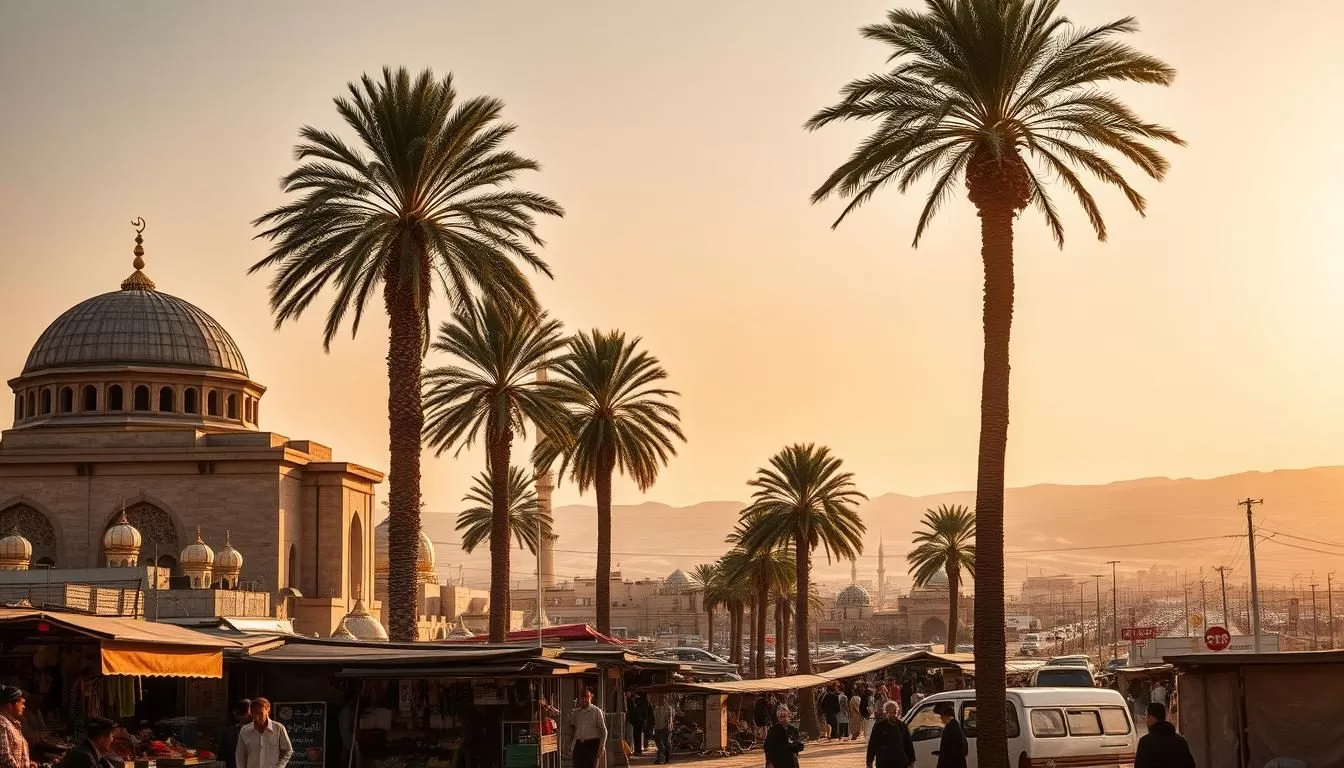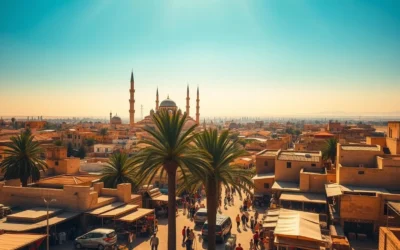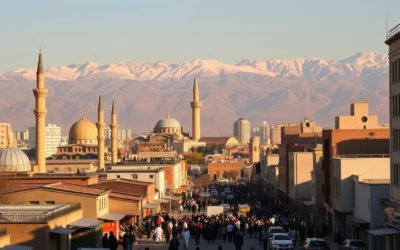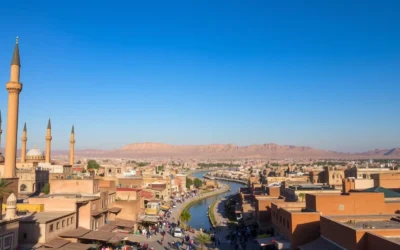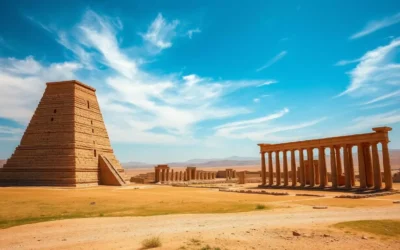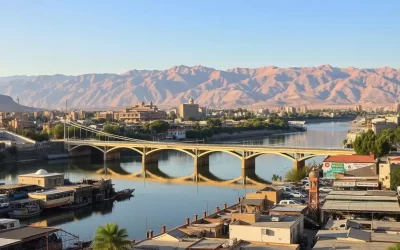✓ Accommodations✓ Flights✓ Rental Cars
Welcome to a city where ancient history meets modern charm. This sacred place is a treasure trove of spiritual and cultural wonders. With a history spanning over 1,400 years, it’s a destination that captivates visitors from around the world.
From its iconic shrines to bustling bazaars, this site offers a unique blend of tradition and vibrancy. Whether you’re drawn to its spiritual significance or its rich heritage, there’s something here for everyone. Discover why this city is a must-visit place for travelers seeking depth and authenticity.
With attractions like the Imam Ali Shrine and Wadi Al-Salam Cemetery, you’ll find yourself immersed in its profound history. The average monthly temperature here is around 90 °F, making it ideal to visit during cooler months like February through April.
Introduction to Najaf and Its Sacred Heritage
Step into a world where spirituality and history intertwine. This ancient city has been a beacon of faith for over 1,400 years, drawing millions of pilgrims annually to its revered shrines. Its streets echo with stories of devotion, making it a living testament to centuries of Islamic tradition.
Setting the Scene for Your Spiritual Journey
As you walk through the old city, you’ll feel the weight of its sacred heritage. The air is thick with reverence, and every corner invites you to pause and reflect. This is a place where faith isn’t just practiced—it’s lived.
Understanding Najaf’s Historical Context
The city’s history is deeply rooted in Shia Islam, with its shrines serving as focal points for spiritual and cultural life. The Imam Ali Shrine, with its grand golden dome, stands as a symbol of this enduring legacy. Its intricate designs showcase the craftsmanship of local artisans, blending beauty with devotion.
Beyond its religious significance, the old city is a treasure trove of history. Its streets are lined with centuries-old architecture, offering a glimpse into the past. Here, tradition and modernity coexist, creating a unique atmosphere that captivates every visitor.
Discover Najaf’s Rich History and Culture
Uncover the layers of history that define this sacred destination. With a legacy spanning over 1,400 years, it has been a center for Islamic learning and a hub for spiritual seekers. Every corner of this city tells a story, inviting you to explore its profound past.
As a visitor, you’ll witness how its ancient roots have shaped its cultural identity. From its role as a pilgrimage site to its influence on Islamic scholarship, the city’s history is deeply intertwined with its spiritual significance. This blend of faith and heritage creates a unique experience for every traveler.
Highlights of its Ancient Legacy
Walking through the streets, you’ll feel the weight of centuries-old traditions. The city’s architecture, with its intricate designs, reflects the craftsmanship of generations. It’s a place where history isn’t just preserved—it’s lived and celebrated.
Key moments in its past have left an indelible mark on its identity. From its rise as a center of learning to its role in shaping Islamic thought, the city’s legacy continues to inspire visitors today. Whether you’re exploring its shrines or strolling through its markets, you’ll find yourself immersed in its timeless charm.
This destination offers more than just a glimpse into the past. It’s a place where history and culture come alive, creating an unforgettable experience for every traveler. Whether you’re drawn to its spiritual significance or its rich heritage, you’ll leave with a deeper appreciation for its enduring legacy.
Explore the Iconic Imam Ali Shrine Complex
Step into the heart of spiritual grandeur at the Imam Ali Shrine Complex. This revered site is a cornerstone of Shia Islam, attracting millions of pilgrims annually. Its golden dome and intricate lattice windows are a testament to its architectural brilliance and spiritual significance.
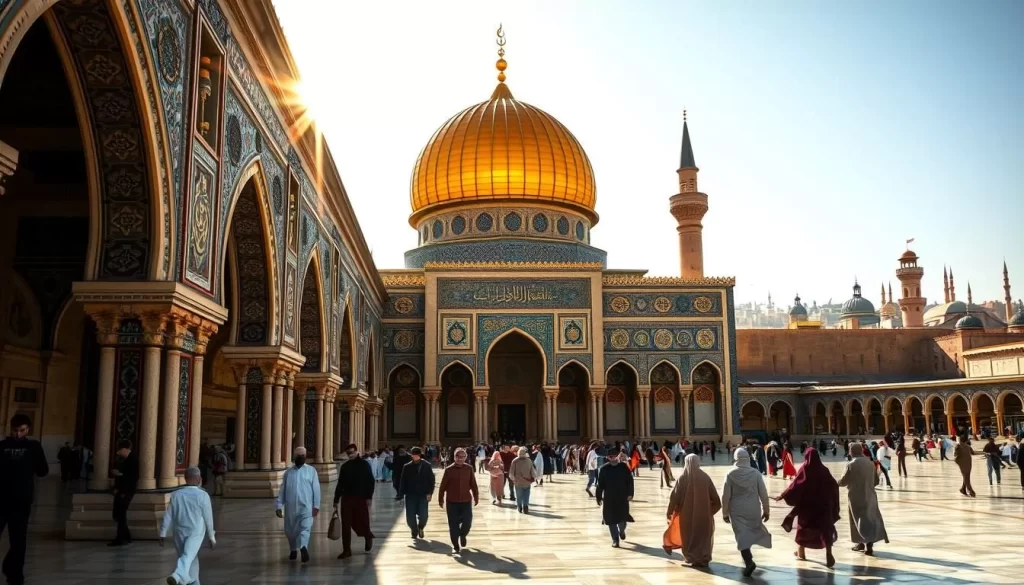
Stunning Architecture and Design Features
The shrine’s golden dome is a breathtaking sight, symbolizing its importance in the region. Inside, you’ll find detailed mosaics and calligraphy that showcase centuries of craftsmanship. The lattice windows allow natural light to illuminate the space, creating a serene atmosphere.
Every corner of the complex tells a story of devotion and artistry. From the grand courtyard to the ornate prayer halls, the design reflects a blend of tradition and innovation. It’s a place where history and faith come alive.
Visitor Etiquette and Best Times to Visit
When visiting, dress modestly to respect the site’s spiritual nature. Women should cover their hair, and both men and women should wear loose-fitting clothing. This ensures a respectful experience for all visitors.
Plan your visit during cooler months, like October to March, to avoid the intense summer heat. Early mornings or late afternoons are ideal to avoid crowds and fully appreciate the shrine’s tranquility.
By following these tips, you’ll enhance your experience and gain a deeper connection to this sacred place. Whether you’re here for spiritual reflection or to admire its beauty, the Imam Ali Shrine Complex is a must-see in the region.
Experience the Spiritual Wadi Al-Salam Cemetery
Walk through a monumental site that tells stories of faith and legacy. Wadi Al-Salam Cemetery is one of the largest burial grounds in the world, stretching over miles and containing millions of tombs. This sacred space is a place of serene reflection, where history and spirituality intertwine.
As you stroll along its tranquil streets, you’ll encounter meticulously crafted tombs and mausoleums. These structures serve as the final home for scholars, religious leaders, and ordinary citizens who have shaped Islamic history. Each building tells a story, offering a glimpse into the lives of those who rest here.
Guided Tours and Historical Insights
To fully appreciate the cemetery’s significance, consider joining a guided tour. Knowledgeable guides provide deeper insights into the historical and spiritual importance of this site. You’ll learn about the notable figures buried here and the architectural marvels that mark their final resting place.
The experience of walking through these historic streets is both humbling and enlightening. The cemetery’s role as a building of memory is vital to the city’s spiritual landscape. It’s a place where the past and present coexist, offering visitors a profound connection to Islamic heritage.
Whether you’re here for spiritual reflection or to explore its historical depth, Wadi Al-Salam Cemetery is a must-visit. Its peaceful ambiance and rich legacy make it a cornerstone of the region’s cultural and spiritual identity.
Najaf, Iraq: Best Things to Do – Top Picks
Discover the heart of a city where spirituality and culture meet. This sacred destination offers a unique blend of history, faith, and vibrant experiences. Whether you’re a first-time visitor or a seasoned traveler, you’ll find something here that resonates deeply.
Overview of Top Attractions
The Imam Ali Shrine stands as a cornerstone of this city’s spiritual identity. Its golden dome and intricate designs draw millions of pilgrims annually, making it a must-visit site. The shrine’s architecture is a testament to centuries of craftsmanship and devotion.
Beyond the shrine, the city’s cultural richness shines through its historic sites and bustling markets. Each attraction tells a story of faith, tradition, and community. Exploring these places offers a deeper understanding of the city’s enduring legacy.
Essential Recommendations for First-Time Visitors
When visiting the Ali Shrine, dress modestly to respect its sacred nature. Women should cover their hair, and both men and women should wear loose-fitting clothing. This ensures a respectful experience for all visitors.
Plan your trip during cooler months, like spring or autumn, to enjoy mild weather and avoid the intense summer heat. Early mornings or late afternoons are ideal for visiting the shrine, as they offer a quieter and more reflective atmosphere.
Take time to explore the city’s other attractions, such as its historic bazaars and cultural landmarks. These experiences provide a well-rounded view of the city’s charm and significance.
Stroll Through Najaf’s Old City and Bustling Bazaars
Immerse yourself in the vibrant atmosphere of the old city and its bustling markets. Here, every corner tells a story of history, offering a glimpse into the rich cultural heritage that has shaped this sacred destination.
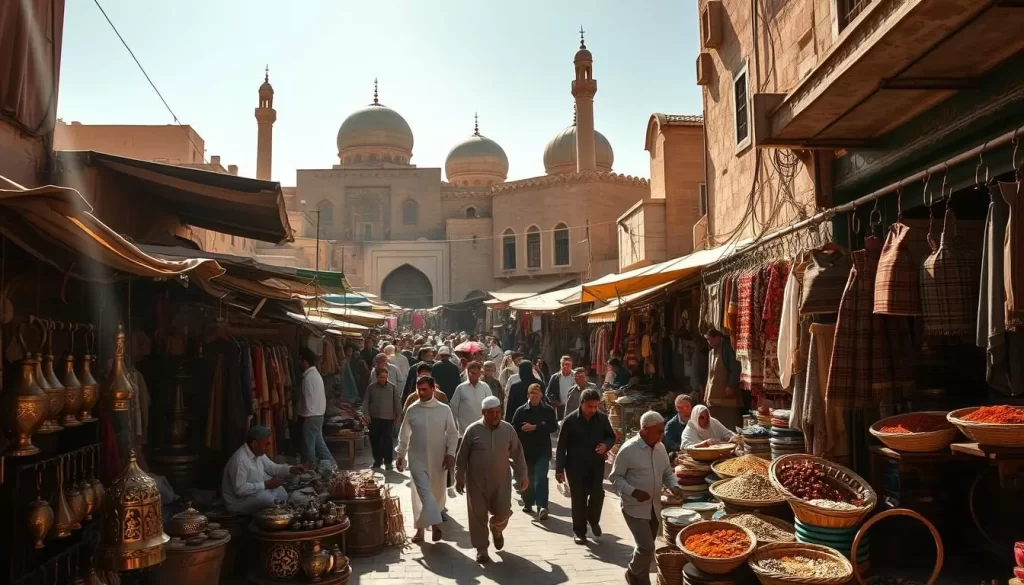
Wander through narrow, historic streets lined with over 800 historical sites, including mosques, shrines, and traditional markets. The bazaars, with around 200 shops, are a treasure trove of textiles, spices, and religious artifacts, reflecting the way this city has developed over centuries.
As you explore, you’ll find exquisite souvenirs that capture the essence of the old city. These markets are not just places to shop but also hubs of social interaction, where about 40% of shop owners are women, showcasing the evolving dynamics of the local economy.
Exploring Traditional Markets and Souvenirs
Don’t miss the chance to visit nearby significant sites like the mosque kufa, which complements your cultural journey. This blend of tradition and modernity creates a unique experience, making the old city a must-visit for any traveler.
Your guide here will help you navigate the bustling bazaars, ensuring you uncover the best finds while appreciating the historical layers that make this place so special. Whether you’re here for the history or the vibrant atmosphere, the old city promises an unforgettable adventure.
Taste Traditional Iraqi Cuisine in Najaf
Dive into the flavors of a culinary heritage that has been perfected over centuries. This city offers a unique blend of traditional dishes and vibrant street food, making it a must-visit attraction for food lovers. From savory meats to aromatic spices, every bite tells a story of culture and tradition.
Local Dishes and Street Food Delights
Start your culinary journey with Masgouf, a grilled fish dish that’s a staple in the region. Another must-try is Quzi, a flavorful lamb and rice dish often served during special occasions. These dishes showcase the rich heritage of Iraqi cuisine.
For a quick bite, explore the bustling street food scene. Try Kubba, a fried or baked dumpling filled with spiced meat and rice. Don’t miss Falafel, a crispy chickpea fritter that’s perfect for a snack on the go.
Coffee Culture and Dining Experiences
Iraqi coffee culture is a highlight of any visit. Enjoy a cup of Turkish coffee, a popular choice in local cafes. The rich, bold flavor pairs perfectly with sweet pastries like Baklava.
For a memorable dining experience, visit traditional restaurants that serve authentic dishes in a cozy setting. These spots often feature live music, adding to the vibrant atmosphere.
“Iraqi cuisine is a celebration of history, culture, and community. Every dish is a testament to the country’s rich culinary traditions.”
| Dish | Description | Best Time to Enjoy |
|---|---|---|
| Masgouf | Grilled fish seasoned with spices | Lunch or dinner |
| Quzi | Lamb and rice dish with nuts | Special occasions |
| Kubba | Fried or baked dumplings | Snack or appetizer |
| Turkish Coffee | Rich, bold coffee | Morning or afternoon |
Plan your culinary adventure during the cooler parts of the day to fully enjoy the outdoor dining options. Whether you’re savoring a traditional dish or sipping coffee in a local café, the flavors of this city will leave a lasting impression.
Select Your Ideal Accommodation in Najaf
Find the perfect place to stay in a city rich with history and culture. Whether you’re seeking luxury or budget-friendly options, there’s something for every traveler. Your choice of accommodation can enhance your experience, placing you at the heart of the city’s most iconic attractions.
Luxury and Mid-Range Options Near Key Attractions
For those who prefer upscale stays, luxury hotels like Dar Al-Salam Hotel and Warth Alanbiyaa Hotel offer stunning views of the Imam Ali Shrine and top-notch amenities. These hotels provide a blend of comfort and convenience, making them ideal for discerning travelers.
Mid-range options, such as Qasr Aldur Hotel and Al Nebras Hotel, are perfect for those seeking comfort without breaking the bank. These accommodations are known for their excellent service and proximity to major sites.
Budget-Friendly Stays for Every Traveler
If you’re traveling on a budget, consider options like Al-Safeer Hotel and Dar Al-Zahra Hotel. These hotels offer clean, simple rooms at affordable rates, ensuring a comfortable stay for every tourist.
Choosing the right accommodation is essential for a memorable trip. Use this guide to find a stay that fits your needs and enhances your journey. Whether you’re here for spiritual reflection or cultural exploration, the right hotel can make all the difference.
Navigate Najaf: Transportation and Travel Tips
Make your journey seamless with practical tips for navigating this historic city. Whether you’re exploring its ancient streets or modern hubs, knowing how to get around will save you time and enhance your experience. From taxis to buses, this guide covers the essentials for every traveler.
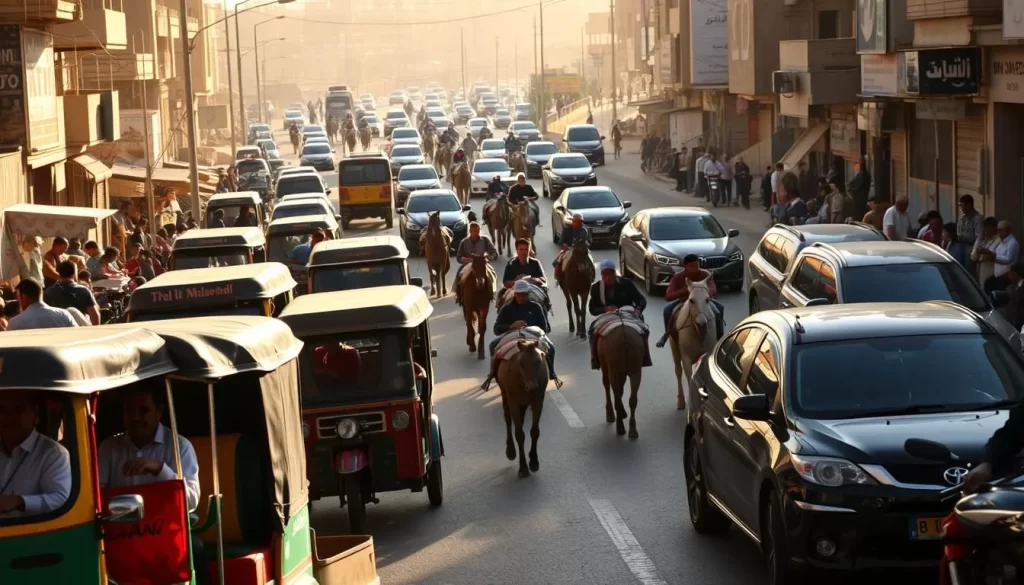
Getting Around the City Easily
Taxis are a convenient way to move around, with fares being relatively low compared to Western standards. However, always negotiate the price before starting your trip, as most taxis don’t have meters. Shared taxis are also available, offering a cost-effective option for traveling between nearby cities like Karbala.
Public buses are another affordable choice, especially for budget-conscious travelers. While they may be crowded, they connect major areas efficiently. For a more scenic route, consider walking through the historic streets, where you’ll discover hidden gems from the past century.
Useful Local Phrases and Safety Tips
Learning a few local phrases can go a long way in making your trip smoother. Simple greetings like “Marhaba” (Hello) and “Shukran” (Thank you) can help you connect with locals. Always carry cash, as most public transport services require it.
Safety is key when traveling. Stick to trusted taxi services or ride-hailing apps, and avoid traveling alone at night. Plan your time wisely, as delays can occur on long-distance routes. For a deeper cultural experience, consider joining a guided tour that explores the city’s historic routes and modern developments over the century.
For a comprehensive travel experience, check out this 10-day itinerary that includes Najaf and other iconic destinations. It’s a great way to immerse yourself in the region’s rich history and culture.
Tour Cultural and Historical Museums in Najaf
Delve into the cultural treasures of a city steeped in history and tradition. Museums here offer a window into the past, showcasing the rich heritage that has shaped this sacred area. Whether you’re a history enthusiast or a curious traveler, these institutions provide a deeper understanding of the city’s legacy.
Discover the Al-Mukhtar Museum
The Al-Mukhtar Museum stands as a testament to the city’s artistic and historical legacy. Established in the early 20th year, it houses a collection of artifacts that highlight the region’s cultural evolution. From ancient manuscripts to intricate artworks, the exhibits offer a glimpse into the lives of those who shaped this area.
Visitors can explore displays that chronicle significant events and figures, making it a must-visit for any pilgrim of culture. The museum’s architecture itself is a marvel, blending traditional designs with modern elements. Plan your visit during the cooler months to fully enjoy the experience.
Other Cultural Highlights Worth Visiting
Beyond the Al-Mukhtar Museum, the city boasts several other cultural gems. Each institution offers a unique perspective on the region’s history and traditions. Here are a few highlights:
- Heritage Museum: Focuses on the city’s role as a center of Islamic learning.
- Art Gallery: Showcases contemporary works by local artists.
- Historical Archives: Preserves documents and records from centuries past.
These museums serve as bridges, connecting modern visitors with the events and traditions of earlier years. They are ideal for travelers seeking to immerse themselves in the cultural fabric of the area.
For the best experience, visit during spring or autumn when the weather is mild. This ensures a comfortable and enriching journey for every pilgrim of culture.
Visit the Revered Kufa Mosque
Explore a site where history and faith converge in a profound way. The Kufa Mosque is not just a place of worship but a cornerstone of Islamic heritage. Its story is woven into the fabric of early Islamic events, making it a must-visit for anyone interested in the region’s spiritual and cultural legacy.
Historical Significance and Visitor Insights
Dating back to the 7th century, the Kufa Mosque is one of the oldest surviving mosques in the world. It holds immense historical importance, having been associated with key figures in Islamic history. The mosque’s architecture reflects the craftsmanship of its time, with intricate designs that continue to inspire awe.
Visitors can learn about the mosque’s role in shaping modern religious practices. Its legacy is a testament to the enduring influence of early Islamic culture. Whether you’re here for spiritual reflection or historical exploration, the mosque offers a unique experience.
Practical Tips for Your Visit
To make the most of your visit, plan your trip during cooler months like spring or autumn. This ensures a comfortable experience as you explore the mosque’s grounds. Dress modestly to respect the site’s sacred nature, and consider joining a guided tour for deeper insights into its history.
For more details on nearby attractions, check out this guide to Kufa’s holy sites. It’s a great way to enhance your journey and discover other significant landmarks in the area.
The Kufa Mosque is more than just a thing to see—it’s a living piece of history. Its spiritual and cultural significance makes it a highlight of any travel itinerary. Whether you’re drawn to its architecture or its legacy, this site promises an unforgettable experience.
Experience Unique Day Trips from Najaf
Expand your journey beyond the city’s spiritual core with unforgettable day trips. These excursions offer a chance to explore the natural beauty and cultural richness surrounding this sacred destination. Whether you seek tranquility or adventure, there’s something for every traveler.
Lake Najaf Cruise and Scenic Surroundings
Take a serene cruise on Lake Najaf and soak in the breathtaking views. The calm waters and picturesque landscapes make it a perfect escape from the bustling city. This experience is ideal for those looking to relax and connect with nature.
Guided tours are available, offering insights into the lake’s ecological and cultural significance. You’ll learn about its role in the region and its connection to Shia Islam. Plan your visit during the cooler months for the best experience.
Adventurous Excursions to the Mesopotamian Marshes
For a more thrilling adventure, head to the Mesopotamian Marshes. These wetlands are a UNESCO World Heritage Site, known for their unique ecosystem and historical significance. A guided tour here will take you through waterways teeming with wildlife and ancient traditions.
You can arrange a half-day or overnight tour, depending on your schedule. Costs for a marsh tour with a vendor are about $30 for two people, lasting 4-5 hours. This is a must-visit for nature enthusiasts and history buffs alike.
| Day Trip | Highlights | Best Time to Visit |
|---|---|---|
| Lake Najaf Cruise | Scenic views, serene atmosphere | Spring or autumn |
| Mesopotamian Marshes | Wildlife, historical significance | Year-round (cooler months preferred) |
These day trips enrich your itinerary, offering a blend of serenity and adventure. Whether you’re cruising on Lake Najaf or exploring the marshes, you’ll create lasting memories. For more travel inspiration, check out this guide to Najaf, Iraq.
Explore the Vibrant Art and Culture Scene
Discover a thriving art scene that blends tradition with modern creativity. This city is home to a growing number of galleries and cultural hubs, offering a unique space for dialogue and expression. Whether you’re an art enthusiast or a curious traveler, these spaces provide a deeper connection to the local culture.
Visiting Local Galleries and Cultural Hubs
Immerse yourself in the vibrant art scene that brings together traditional and contemporary expressions. Local galleries showcase works by talented artists, reflecting the rich heritage of the region. These spaces are popular among shia muslims and art lovers alike, offering a glimpse into the creative energy of the city.
Cultural hubs are not just places to view art—they’re community centers where ideas are exchanged. Live exhibitions and interactive displays make these spaces dynamic and engaging. They’re perfect for anyone looking to enrich their trip with cultural experiences.
Here are some notable art spaces to explore:
- Al-Mukhtar Art Gallery: Known for its contemporary works and cultural events.
- Heritage Center: Focuses on traditional art forms and historical exhibits.
- Creative Hub: A space for interactive art displays and workshops.
These galleries and hubs contribute to the city’s cultural identity, making them a must-visit during your trip. They’re also great places to relax and enjoy a meal at a nearby restaurant, where you can savor local flavors while reflecting on the art you’ve seen.
| Art Space | Highlights | Best Time to Visit |
|---|---|---|
| Al-Mukhtar Art Gallery | Contemporary art, cultural events | Weekdays for fewer crowds |
| Heritage Center | Traditional art, historical exhibits | Morning hours |
| Creative Hub | Interactive displays, workshops | Afternoons for live events |
Exploring these spaces is a rewarding way to connect with the city’s artistic soul. Whether you’re here for a short visit or an extended stay, the art and culture scene will leave a lasting impression on your trip.
Plan Your Trip: Best Time to Visit Najaf
Plan your journey to this sacred destination with insights on the best times to visit. Timing your trip can enhance your experience, ensuring comfortable weather and fewer crowds. Whether you’re drawn to cultural festivals or serene exploration, this guide will help you make the most of your visit.
Weather Considerations and Seasonal Tips
The climate here varies significantly throughout the year. Summers can be intense, with temperatures often exceeding 40°C (104°F). For a more comfortable experience, consider visiting during spring (March to May) or autumn (September to November).
These seasons offer mild weather, making it easier to explore outdoor attractions. Winter months are cooler but can occasionally bring rain, so pack accordingly. Planning your trip around these periods ensures a pleasant and memorable journey.
Timing Your Visit Around Local Festivals
Local festivals provide a unique view into the region’s vibrant culture. Major events like Arbaeen attract millions of pilgrims, creating a lively atmosphere. While these festivals are fascinating, they can also lead to crowded conditions and higher accommodation costs.
If you prefer a quieter experience, avoid peak pilgrimage times. Instead, opt for off-peak months like April or October. This allows you to enjoy the city’s charm without the hustle and bustle.
| Season | Highlights | Best For |
|---|---|---|
| Spring (March-May) | Mild weather, blooming landscapes | Outdoor exploration |
| Autumn (September-November) | Comfortable temperatures, fewer crowds | Cultural immersion |
| Winter (December-February) | Cooler weather, occasional rain | Indoor activities |
| Summer (June-August) | Hot temperatures, vibrant festivals | Festival enthusiasts |
For more detailed advice on planning a trip, check out this comprehensive guide. It offers additional tips on travel logistics, attractions, and cultural experiences.
Additional Tips for a Memorable Journey
Make your visit unforgettable with these essential travel tips. From navigating bustling markets to understanding local customs, these practical suggestions will enhance your experience and ensure a smooth journey.
Navigating Bustling Bazaars
Exploring the city’s vibrant bazaars is a must. These markets are filled with unique finds, from spices to handmade crafts. To make the most of your visit, arrive early to avoid crowds and take your time browsing. Bargaining is common, so don’t hesitate to negotiate prices politely.
For a more immersive experience, consider hiring a local guide. They can provide valuable information about the history and significance of the items you’ll find. This is especially helpful in understanding the cultural context of the bazaar and its role in daily life.
Understanding Local Customs
Respecting local traditions is key to a positive experience. Dress modestly, especially when visiting religious sites. Women should cover their hair, and both men and women should wear loose-fitting clothing. This shows respect for the sacred nature of these places.
When interacting with locals, a friendly greeting like “Marhaba” (Hello) can go a long way. Learning a few basic phrases in Arabic can also enhance your connection with the community. Always ask for permission before taking photos, especially in sensitive areas like tombs or religious sites.
Enhancing Your Visit to Historical Tombs
Historical tombs are a significant part of the city’s heritage. When visiting, take time to learn about the figures buried there and their contributions to history. Guided tours are available and provide in-depth information about these sites.
Plan your visit during cooler parts of the day to avoid the heat. This allows you to fully appreciate the architecture and atmosphere of these sacred spaces. Remember to maintain a respectful demeanor, as these sites hold deep spiritual significance.
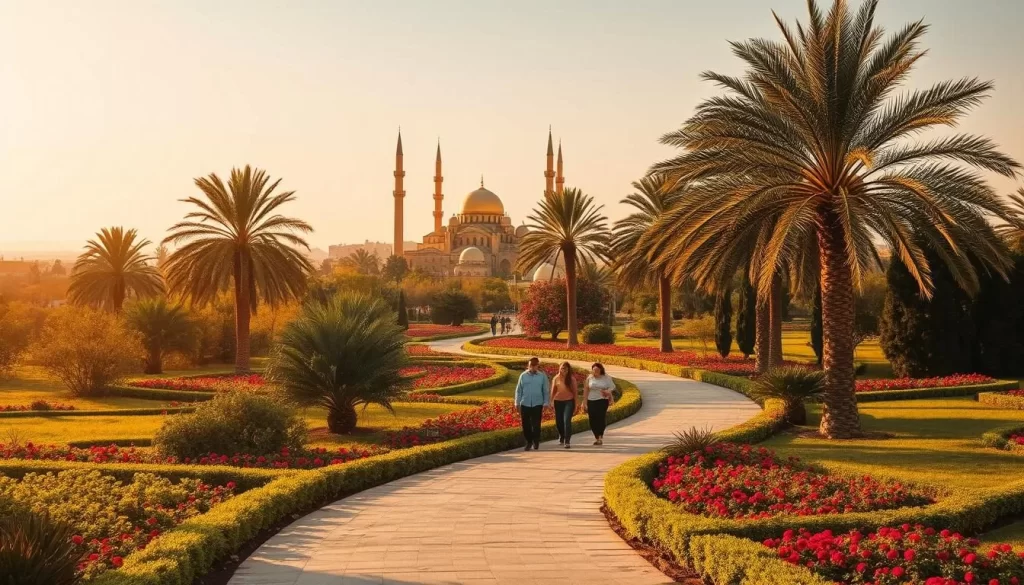
“Traveling is not just about seeing new places; it’s about understanding and respecting the cultures that make them unique.”
For more detailed advice on planning your trip, check out this guide to Najaf, Iraq. It’s a great resource for first-time visitors and seasoned travelers alike.
Conclusion
As your journey comes to a close, reflect on the spiritual and cultural richness you’ve experienced. From the iconic shrines to the bustling markets, this destination offers a blend of history and vibrancy that leaves a lasting impression. Respecting local customs, such as dressing modestly at religious sites, ensures a meaningful and respectful visit.
Plan your next trip with the insights gathered here. Whether you’re drawn to the serene ambiance of sacred spaces or the lively energy of traditional markets, there’s always more to explore. Don’t forget to sample the street food, a delightful way to connect with the local culture and flavors.
This city’s rich history and vibrant culture make it a truly unforgettable destination. Embrace the opportunity to dive deeper into its heritage and create memories that will stay with you long after your visit. Your next adventure awaits—start planning today!
The above is subject to change.
Check back often to TRAVEL.COM for the latest travel tips and deals.
